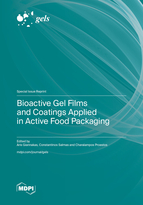Bioactive Gel Films and Coatings Applied in Active Food Packaging
A special issue of Gels (ISSN 2310-2861). This special issue belongs to the section "Gel Applications".
Deadline for manuscript submissions: closed (31 July 2023) | Viewed by 22831
Special Issue Editors
Interests: chemical technology; nanostructures in food technology; polymers and biopolymers composites and nanocomposites; biopolymers hydrogels; bioactive nanostructures; nanomaterials; microemulsions; nanoemulsions; active packaging; control release; food processing and preservation
Special Issues, Collections and Topics in MDPI journals
Interests: process engineering; porous materials; material characterization; kinetics; mesoporous materials; chemical engineering; catalyst characterization; BET surface area measurement; hydrogen production; stable isotopes; biomass
Special Issues, Collections and Topics in MDPI journals
Interests: antioxidants; bioactive compounds; essential oils; plant extracts; food chemistry; food analysis
Special Issues, Collections and Topics in MDPI journals
Special Issue Information
Dear Colleagues,
Recently, the trends in circular economy and sustainability have driven nanotechnology towards the development of novel and innovative applications in the food packaging sector, which is rather recent compared with their use in biomedical and pharmaceutical applications. Bioactive films and coatings based on natural biopolymers such as chitosan, sodium alginate and gelatin, and containing antioxidant and antimicrobial agents such as micro- and nanoemulsions of phytochemicals and nanostructured materials such as quantum dots, ZnO nanoparticles, nanoclays, silicas, zeolites and activated carbons, are finding application in various sectors of the food industry, especially in the development of novel edible active packaging films and coatings. These bioactive films and coating materials enhance solubility, improve bioavailability, facilitate controlled release, and protect bioactive components during manufacture and storage. This Special Issue intends to provide an overview of bioactive gel films and coatings applied in active food packaging.
Prof. Dr. Aris E. Giannakas
Prof. Dr. Constantinos E. Salmas
Prof. Dr. Charalampos Proestos
Guest Editors
Manuscript Submission Information
Manuscripts should be submitted online at www.mdpi.com by registering and logging in to this website. Once you are registered, click here to go to the submission form. Manuscripts can be submitted until the deadline. All submissions that pass pre-check are peer-reviewed. Accepted papers will be published continuously in the journal (as soon as accepted) and will be listed together on the special issue website. Research articles, review articles as well as short communications are invited. For planned papers, a title and short abstract (about 100 words) can be sent to the Editorial Office for announcement on this website.
Submitted manuscripts should not have been published previously, nor be under consideration for publication elsewhere (except conference proceedings papers). All manuscripts are thoroughly refereed through a single-blind peer-review process. A guide for authors and other relevant information for submission of manuscripts is available on the Instructions for Authors page. Gels is an international peer-reviewed open access monthly journal published by MDPI.
Please visit the Instructions for Authors page before submitting a manuscript. The Article Processing Charge (APC) for publication in this open access journal is 2600 CHF (Swiss Francs). Submitted papers should be well formatted and use good English. Authors may use MDPI's English editing service prior to publication or during author revisions.
Keywords
- biopolymers
- edible films and coatings
- essential oils
- natural extracts
- emulsions
- nanoemulsions
- nanoparticles
- active packaging









